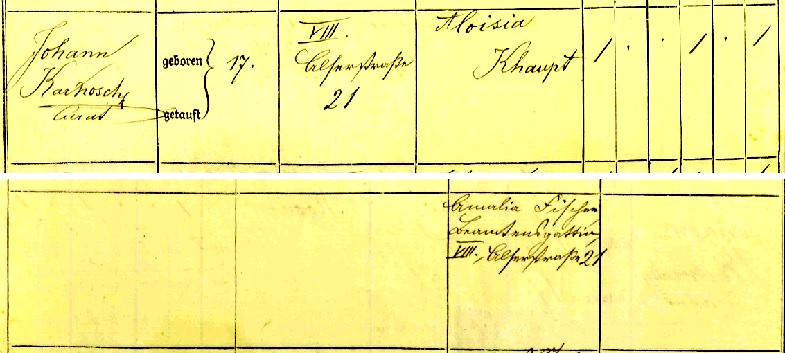|
The
|
|
THE BURGENLAND BUNCH NEWS - No. 328 February 28, 2022, © 2022 by The Burgenland Bunch All rights reserved. Permission to copy excerpts granted if credit is provided. Editor: Thomas Steichen (email: tj.steichen@comcast.net) BB Home Page: the-burgenland-bunch.org BB Newsletter Archives: BB Newsletters BB Facebook Page: TheBurgenlandBunchOFFICIAL Our 26th year! The Burgenland Bunch Newsletter is issued monthly online. The BB was founded in 1997 by Gerald Berghold, who died in August 2008. |
|
| Current Status Of The BB: * Members: 3116 * Surname Entries: 9083 * Query Board Entries: 5886 * Staff Members: 13 |
|
This newsletter concerns: 1) THE PRESIDENT'S CORNER 2) FINDING OUR BUGNITZ BURGENLAND FAMILY (by Eileen and Christine Bugnitz) 3) HISTORICAL BB NEWSLETTER ARTICLES: - A VIENNA ORPHAN (by John Holler) 4) ETHNIC EVENTS 5) BURGENLAND EMIGRANT OBITUARIES (courtesy of Bob Strauch) |
|
1) THE PRESIDENT'S CORNER (by Tom Steichen)  My
Covid note for the US is via a graph from the CDC, dated February 17 (the "today" on the graph). It shows the
weekly Covid deaths for the US from the beginning of the pandemic until the date of the graph, then forecasts
an additional four weeks (the few red points beyond the "today" marker). My
Covid note for the US is via a graph from the CDC, dated February 17 (the "today" on the graph). It shows the
weekly Covid deaths for the US from the beginning of the pandemic until the date of the graph, then forecasts
an additional four weeks (the few red points beyond the "today" marker).  What
should be apparent is the initial spike in deaths as the pandemic began in early 2020, a much bigger spike in early 2021
when the virus had spread fully across the country and winter hit again, the great drop in deaths as winter ended and the
vaccine became available, the new spike as the Delta variant took hold, which was countered by the booster
campaign... but frustrated by the Omicron variant, which created a new spike of its own. The good news is that we
seem to be past the Omicron peak and the forecast calls for a continuing decline in deaths. What
should be apparent is the initial spike in deaths as the pandemic began in early 2020, a much bigger spike in early 2021
when the virus had spread fully across the country and winter hit again, the great drop in deaths as winter ended and the
vaccine became available, the new spike as the Delta variant took hold, which was countered by the booster
campaign... but frustrated by the Omicron variant, which created a new spike of its own. The good news is that we
seem to be past the Omicron peak and the forecast calls for a continuing decline in deaths.This month's random bits and pieces (Article 1) begins with a description of what FamilySearch.org is planning for 2022, counters with a bit about what Ancestry.com is planning for the 1950 census, swerves to Austria and the latest population statistics for it and Burgenland, revisits the salt lakes of northern Burgenland and a new plan to revitalize that system, looks into what's been shaking in regard to earthquakes in Austria, makes note of an honor for the president of ÖFR, and ends with a notice of new transcribed records, these for civil death records for Jennersdorf. Our regular tidbits kick off with the monthly update on corona-virus happenings in Burgenland and continue with the monthly BB Facebook report, book sales, a recipe and a cartoon-of-the-month. In Article 2, we present the second story from relatives of Werner Stubits... this one about Finding Our Bugnitz Burgenland Family by sisters Eileen and Christine Bugnitz. Eileen tells the main story and Christine provides a poem expressing her feelings about their discoveries. The remaining articles are our standard sections: A Historical BB Newsletter article, Ethnic Events and Emigrant Obituaries.  What
to Expect from FamilySearch in 2022: The FamilySearch blog recently published a teaser on things they will be
working on in 2022. They plan to introduce "a marriage of artificial intelligence and crowd-sourcing that is sure to
deliver millions of inspiring family discoveries for years to come." What
to Expect from FamilySearch in 2022: The FamilySearch blog recently published a teaser on things they will be
working on in 2022. They plan to introduce "a marriage of artificial intelligence and crowd-sourcing that is sure to
deliver millions of inspiring family discoveries for years to come." The intent is to announce a "new online volunteer experience and integrated mobile app" at RootsTech 2022 in early March that they hint will make crowd-sourcing of record contributions more personalized and relevant to one's own personal family tree. Sort of "blurring the lines between volunteering and making personal family history discoveries," according to FamilySearch product manager, Ian James. In addition, they plan to reveal a new artificial-intelligence-driven handwriting-recognition technology to speed transcription and indexing of records. Apparently, this has been under test in Spanish-speaking countries for the past year, and the claim is that it allowed FamilySearch "to produce in one year what would have otherwise taken us a hundred years to do with previous technology." Perhaps less relevant to our BB researchers are a couple of additional initiatives, one of which intends to customize family research in Asia with a new family tree visualization and documentation tool that "will better reflect the record-keeping traditions and processes of Asian cultures that view their ancestors in a 'top-down tree' perspective." The other is targeted at Africa and Middle East with presentation tools that "artistically preserve and illustrate their family history in a variety of beautiful printable keepsakes." One of the first applications of the handwriting-recognition technology in the US will be to generate an initial index for the 1950 Federal Census when the images are released to the public in April. Volunteers will be used to review the automated index to ensure that every name is included and indexed correctly. Sounds like it will be an interesting year at FamilySearch!  Ancestry.com
and the 1950 Federal Census: If you read the "tidbit" above, you know that FamilySearch plans to use
handwriting-recognition technology to generate their initial index for the 1950 Census. Well, Ancestry.com
announced, the day before the FamilySearch announcement, something similar, saying "Using new, proprietary
Artificial Intelligence (AI) handwriting recognition technology, Ancestry® today announced it will deliver a searchable
index of the 1950 U.S. Census to customers faster than ever before." The target completion is "this summer" with US
states released in real time upon completion. Ancestry.com
and the 1950 Federal Census: If you read the "tidbit" above, you know that FamilySearch plans to use
handwriting-recognition technology to generate their initial index for the 1950 Census. Well, Ancestry.com
announced, the day before the FamilySearch announcement, something similar, saying "Using new, proprietary
Artificial Intelligence (AI) handwriting recognition technology, Ancestry® today announced it will deliver a searchable
index of the 1950 U.S. Census to customers faster than ever before." The target completion is "this summer" with US
states released in real time upon completion.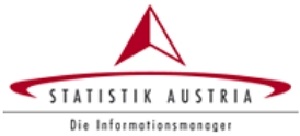 Population Growth
in Austria and Burgenland: Statistics Austria reports that the number of people living in Austria rose
by 0.53 percent, to just under 8,980,000 during 2021. In Burgenland, 297,623 people were counted, with about ten
percent being foreign nationals. As in other recent years, people with foreign citizenship are responsible for the slight
growth in population, without which both Burgenland and Austria would have shrunk. In Burgenland, more babies were born than
in the previous year, 2,230, but that was more than offset by the 3,590 deaths in Burgenland. The Burgenland state capital's
Eisenstadt district recorded the strongest percentage growth in all of Austria at the district level, with a
population increase of around 2.3 percent. Population Growth
in Austria and Burgenland: Statistics Austria reports that the number of people living in Austria rose
by 0.53 percent, to just under 8,980,000 during 2021. In Burgenland, 297,623 people were counted, with about ten
percent being foreign nationals. As in other recent years, people with foreign citizenship are responsible for the slight
growth in population, without which both Burgenland and Austria would have shrunk. In Burgenland, more babies were born than
in the previous year, 2,230, but that was more than offset by the 3,590 deaths in Burgenland. The Burgenland state capital's
Eisenstadt district recorded the strongest percentage growth in all of Austria at the district level, with a
population increase of around 2.3 percent.The coronavirus remained a stumbling block for marriages in Burgenland. Although more couples were married in 2021 than in 2020, the 1,180 marriages were still significantly fewer than in pre-Covid 2019. However, divorces declined in Burgenland: the 440 divorces represent a decrease of about 7% compared to 2020. Burgenland Seeking Funding To Restore Its Salt Lakes (Salzlacken): According to a study that examined the condition of the salt lakes in the Seewinkel, not a single one of the sixty-six they looked at can be preserved in the long term without restoration measures. Only five were deemed to be currently in reasonably healthy condition, the rest in moderate to poor condition. I wrote about these salt lakes last October, noting that plans were being developed to preserve this inland salt region (the largest in Europe) and improve the groundwater situation. 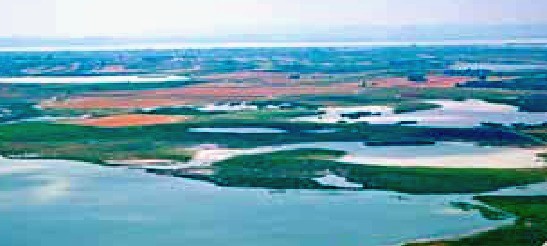 These ideas have been submitted
to the EU as a project. Astrid Eisenkopf, the responsible SPÖ state councilor, stated that "Of course, we hope
that we will be awarded this contract, at least once we have advanced to the last round. We will probably receive the
information as to whether we will be awarded the contract for the project at the end of April. This would then run for seven
years with a project volume of more than eleven million euros." These ideas have been submitted
to the EU as a project. Astrid Eisenkopf, the responsible SPÖ state councilor, stated that "Of course, we hope
that we will be awarded this contract, at least once we have advanced to the last round. We will probably receive the
information as to whether we will be awarded the contract for the project at the end of April. This would then run for seven
years with a project volume of more than eleven million euros."A number of other projects in the Lake Neusiedl - Seewinkel National Park are scheduled to be completed this year, including a redesign of the outdoor area of the National Park Information Centre in Illmitz (a redesign of the interior was recently completed). The outdoor redesign is intended to further promote gentle, nature-oriented tourism, add space for visiting school classes, and make the park more inviting for recreational cyclists. The national park management also plans to further increase biodiversity, even though the park already is the most biodiverse park in Austria, especially for birds. Earthquake Swarm Near Burgenland: According to the Austrian Central Institute for Meteorology and Geodynamics, in the month since mid-January, there have been 320 small earthquakes in the Wiener Neustadt area, just adjacent to Burgenland. Most are mild, with only seven felt by the population. Seismologist Rita Meurers from the Central Institute said it is a very unusual accumulation of earthquakes, being more common in Tyrol. But it is good, as it leads to a gradual release of energy. Earthquakes that caused major damage were last recorded in the 17th and 18th centuries, though a January 1972 earthquake of magnitude 4.1 in Wiener Neustadt caused slight damage to buildings. Throughout 2021, 35 noticeable earthquakes were recorded in Austria. The chart below shows where they occurred, including one in northern Burgenland and quite a few in the adjacent Wiener Neustadt area.   Leopold
Strenn, President of the ÖFR, receives the Golden Medal of Honor for Services to the Province of
Lower Austria: In both this and the past month's newsletter, I published articles that originally appeared in the
newsletter of ÖFR (= Austrian Society for Family and Regional Historical Research). Well, it turns out that the
founder and current president of ÖFR, Leopold Strenn, was just awarded the Golden Medal of Honor for
services to the federal state of Lower Austria. He had also been twice honored by the Republic of Austria, first in 1994
with the Austrian Golden Medal of Honor and again in 2012 with the Austrian Grand Medal of Honor, both awarded
by the Federal President. Leopold
Strenn, President of the ÖFR, receives the Golden Medal of Honor for Services to the Province of
Lower Austria: In both this and the past month's newsletter, I published articles that originally appeared in the
newsletter of ÖFR (= Austrian Society for Family and Regional Historical Research). Well, it turns out that the
founder and current president of ÖFR, Leopold Strenn, was just awarded the Golden Medal of Honor for
services to the federal state of Lower Austria. He had also been twice honored by the Republic of Austria, first in 1994
with the Austrian Golden Medal of Honor and again in 2012 with the Austrian Grand Medal of Honor, both awarded
by the Federal President.After completing military service, Leopold studied surveying and eventually worked at the Federal Office of Calibration and Surveying in Vienna and as a university lecturer at the University of Vienna. In retirement, he founded the Genealogenstammtisch (= genealogists' table) in Vienna, from which regular meetings in Lower Austria developed. Five years ago, he founded ÖFR and has been its president ever since. We congratulate Leopold on this award for his work with ÖFR and wish him continued success!  Jennersdorf
Death Records: We are pleased to announce that Ferenc Zotter's complete transcriptions of all 3,600
death records from 1895 through 1920 for the civil recording district of Jennersdorf are now available on the BB
website. We thank him for sharing his work. Jennersdorf (Hungarian: Gyanafalva) was the official
civil recording location for itself, Grieselstein (Hungarian: Köröstyén, Kristyán),
Henndorf (Hungarian: Ercsenye) and Rax (Hungarian: Raks). Jennersdorf
Death Records: We are pleased to announce that Ferenc Zotter's complete transcriptions of all 3,600
death records from 1895 through 1920 for the civil recording district of Jennersdorf are now available on the BB
website. We thank him for sharing his work. Jennersdorf (Hungarian: Gyanafalva) was the official
civil recording location for itself, Grieselstein (Hungarian: Köröstyén, Kristyán),
Henndorf (Hungarian: Ercsenye) and Rax (Hungarian: Raks).The source for the data is FamilySearch digital record collections # 5036121 (1895-1903) and # 5036122 (1904-1920), found here: https://familysearch.org/search/film/005036121?cat=77007 and https://familysearch.org/search/film/005036122?cat=77007. You can access the transcribed records here: JennersdorfRecords or via our homepage.  Corona
Virus in Burgenland: Austria continues with no entry restrictions for travelers arriving from the
United States other than a proof of vaccination, proof of recovery from COVID-19 or a negative Covid-19 test result that
must be presented upon entry. Corona
Virus in Burgenland: Austria continues with no entry restrictions for travelers arriving from the
United States other than a proof of vaccination, proof of recovery from COVID-19 or a negative Covid-19 test result that
must be presented upon entry.As for the Austria-wide compulsory vaccination, scheduled to begin enforcement on February 4th, it already began making news on the first day of the month with an article that noted that this also affected partially-vaccinated individuals. Apparently in Burgenland there were around 12,400 vaccination certificates that expired on February 1st, meaning these people would also be out of compliance when compulsory vaccination began. So in addition to the approximately 30,000 totally unvaccinated individuals, there are these additional people who will need to get vaccinated again or suffer consequences. In Burgenland, the vaccination obligation applies to everyone age 18 or older who are not medically exempted. About 88% have had at least one coronavirus vaccination. But, a single vaccination alone is now not enough to obtain a valid vaccination certificate; you either have to recover and be vaccinated once, or you have to be vaccinated twice, and the second vaccination must not be more than six months old. With a third, booster vaccination, the certificate is valid for nine months. Despite the compulsory vaccination, unvaccinated people are able to participate in public life largely without restriction because the 2G rule in stores ended on February 12 and only the 3G rule applied after the 19th for gastronomy, the hotel industry and events, meaning that a negative test suffices for a restaurant visit or hotel stay. However, further confusion arose by mid-month when it became clear that penalties for the unvaccinated would apply only after March 15th... then the Federal government indicated that it plans to drop all "G" rules by March 5th, without saying how that affects the compulsory vaccination obligation. Burgenland Governor Hans Peter Doskozil said he welcomed the reduced restrictions but he also had expected a discussion about the vaccination obligation, calling it a contradiction to do the one without addressing the other. Doskozil stated that "It will probably happen that the Commission will suspend the implementation of the vaccination obligation in the next few days or weeks. But I would have expected clear communication today." He also noted that Austria will probably face the same situation this coming autumn as last autumn and argued that the Federal government should have plans in place for the autumn and tell the population what to expect. He stated that "We must not draw the picture that everything is open and then expect to flip the switch again in October and say that you have a tense situation." In particular, he felt there should be a strategy in place for the schools in the autumn and reiterated his earlier idea of an "indirect" vaccination obligation via fee-based testing. A dubious second anniversary: It is worth noting that February 25th, 2020, was the date that the first coronavirus cases were discovered in Austria. By March 6th, cases began appearing in Burgenland. On March 11th, the WHO declared Covid-19 a pandemic and, a day later, the first Covid death in Austria occurred. On March 16th, the first of five lockdowns in Burgenland began. It has been a rough two years. 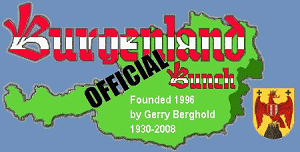 The
Facebook Bunch (from Vanessa Sandhu): The
Facebook Bunch (from Vanessa Sandhu):Greetings, Burgenland Bunch! I hope that everyone is doing well! We had a quiet but productive month in our Facebook group. We welcomed 25 new members, bringing our total membership count up to 1818. If we are still missing you, please come join us! facebook.com/groups/TheBurgenlandBunchOFFICIAL/ Member Rebecca Chamberlain came upon a wonderful find, which she shared with the group. Rebecca found the Catholic Church parish website for Illmitz. On the site, you can find an online database of deaths since 1 Jan 1950. You can find it at: www.pfarre-illmitz.at. We had a good discussion about the use of our Burgenland Bunch DNA projects to help to find relatives and fill in missing pieces of our family trees. The Burgenland Bunch has a DNA study on FamilyTreeDNA. You can transfer your raw data to the project from AncestryDNA and 23andMe: familytreedna.com/project-join-request.aspx?group=Burgenland_DNA The other project is run by our own Ingrid Schuster, and can be found on GEDmatch. It is found in the Ancestor Projects section. After you get your raw DNA, you can upload it to GEDmatch and join the project. Here is the link to the pinned post for the BB’s Facebook GEDmatch project: facebook.com/groups/TheBurgenlandBunchOFFICIAL/2305072666449859 Member Karen Alonzo posed a good question regarding finding your ancestor’s military records in and around Burgenland. Member Joseph R Karner recommended statearchives.gv.at/family-research/kriegsarchiv.html. Member Ingrid Fleischer suggested militaria.hu/. Member Heidi Frank recommended genteam.at for WW-I Military Loss lists. We heard some wonderful button box music from Alex Meixner. Alex explained, “I remember first hearing this song, Landsleut Polka, with Rudi Pietsch from Austria performed with his Tanzgeiger Ensemble in Pennsylvania when I was 8 or 9 years old. It became a favorite song for my Dad to play on his Steirische Harmonike with Bob Strauch on Hackbrett. There are nonsense words that might have to do with a card game... or might just refer to the fact that 'we cannot eat the money in this world....' It might just be better to enjoy this fun Polka as an instrumental!” BB staff member Bob Strauch translated the lyrics for us, saying, “Although I've since heard many variations, here are the words to the trio that we learned from Rudi: Drah ma's auf, drah ma's zua, es liegt nix draun, weil's ma's Göld auf dera Wölt nit fressn kaunn. Schiafe Obsätz und in jedn Strumpf a Loch, owa drahn, owa drahn tamma's noch!” Bob continues, "Turn it on, turn it off, it doesn't matter because we can't eat money on this earth. Crooked heels and a hole in every stocking, but we still keep on turning (dancing).” Enjoy this lovely song! https://youtu.be/ILIP_JaRf4c CONNECTIONS: Member June Schrodel writes: “I'm trying to trace Josef Schrodel -born 1791- he was in the Austrian army. I have found a lot of Schrodels in Stoob, Burgenland, but can't find him or his birth. Can anyone help please, I've been looking for a number of years. Thank you, June.” Wishing you all good health and happiness! Vanessa  Update
for book "The Burgenländer Emigration to America": Here is this month's update on purchases of the English issue of
the 3rd edition of Dr. Walter Dujmovits' book "Die Amerika-Wanderung Der Burgenländer." Update
for book "The Burgenländer Emigration to America": Here is this month's update on purchases of the English issue of
the 3rd edition of Dr. Walter Dujmovits' book "Die Amerika-Wanderung Der Burgenländer."Current total sales are 1646 copies, as interested people purchased 11 more books during this past month. Unfortunately (though it is only a small bit of bad fortune), the price of the book has risen to $8.12 (US), a 71 cent increase from the longtime price of $7.41, as the vendor has raised the production charge. Corresponding prices in other currencies have changed also. As always, the book is available for online purchase, now at a list price of $8.12 (which is the production charge for the book, as we purposely choose not to make a profit so we can avoid dealing with the income tax consequences and so you can obtain the book at as low a cost as possible!), plus tax & shipping. See the BB homepage for a link to the information / ordering page and for information about current discounts (there is at least one discount on price or shipping available most of the time... if not, wait a few days and there will be one!). The book is an excellent read for the Burgenländers in your family. Burgenland Recipes: Heidi Frank writes: Here is my aunt, Walpurga Wukowich's (1934-2014), recipe for "Bratwürstl" (in dialect) or Bratwurst (in German). Tante Burge, as she was known, did everything in a big way. She had a big voice (especially in Croatian), a big smile and cooked in a big way. She and her husband, Mathias, had a very popular Heuriger in the 1980s and '90s at their Hof in Klingenbach. They grew grapes, made wine, raised pigs and she made incredible sausages that were a big draw for the Heuriger. I learned this recipe in 2014 in her summer kitchen, which was fueled by a wood-burning "Sparherd." The original recipe is worth reading just to get a sense for how she cooked. In retirement, she bought her meat from the butcher shop in Stötera. She went in the back, inspected everything and chose her meat while she chatted with the head butcher. Then we put it all in her station wagon, went home and got to work. Her best friend from down the street came to help and to argue about the seasoning. My Onkel Viktor, her brother, was put to work sharpening knives and peeling garlic. We made Preßwurst and Bratwürstl, all on a hot day in August. The results were, of course, memorable. I'm glad I documented what she did so I can pass it on. 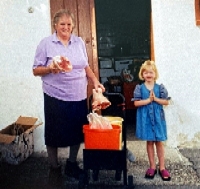 Tante Burge's Bratwürstl
Tante Burge's Bratwürstl (from Heidi Frank) Ingredients: • 7.5 kg pork (fatty pork such as a picnic ham) • 2.5 kg beef (round or similar) • 60 g ground pepper • 2-3 heads of garlic, peeled and finely chopped • 2/3 cup dried marjoram (rubbed to make it fine) • 1/4 cup sweet Hungarian paprika • 200 g salt Preparation: Grind meat in meat grinder. Re-grind 3 kg of meat. Mix pepper and paprika with about 1/2 cup of warm water. Pour over meat. Sprinkle remaining ingredients over meat mixture and mix well using your hands. Fill casings with sausage mixture. Smoke sausage in a cold smoker. Alternatively, form into patties, kebabs, or meatballs. Pan-fry or bake in medium oven until cooked through. Here is an alternate recipe for a more modestly-sized portion with American measurements, in case you don't own a meat grinder.  Bratwürstl for the Home Cook
Bratwürstl for the Home Cook (from Heidi Frank) Ingredients: • 3 lbs ground pork • 1 lb ground beef • 7 Tbsp ground pepper • 1/2 small head of garlic, peeled and finely chopped • 2 Tbsp dried marjoram, rubbed fine • 1 Tbsp sweet Hungarian paprika • 5 Tbsp salt Preparation: Mix all the ingredients well. Shape into patties, kebabs, or meatballs. Pan-fry or bake in 350°F oven until cooked through. Serve with brown mustard, spicy mustard or horseradish mustard. Notes: Authentic Hungarian paprika tastes very different from anything manufactured in the US that is labeled "Hungarian." Also, the key flavor that differentiates Burgenland bratwurst from any German bratwurst, is the marjoram. Try to buy good quality dried marjoram or grow your own. Rubbing it will release the flavors.  Note:
Our recipes sortable list has links directly to the recipes or food-related articles published
in our past newsletters. You can access the list by clicking our recipe box (to the right). Thanks to the contributions of
our members over the years, we have quite a collection of Burgenland recipes, some with several variations. Note:
Our recipes sortable list has links directly to the recipes or food-related articles published
in our past newsletters. You can access the list by clicking our recipe box (to the right). Thanks to the contributions of
our members over the years, we have quite a collection of Burgenland recipes, some with several variations.However, we have now used up our unpublished recipes... thus this recipe section will be dormant whenever we have no recipe to publish. So, if you have a favorite family recipe, please consider sharing it with us. We will be happy to publish it. Our older relatives, sadly, aren't with us forever, so don't allow your favorite ethnic dish to be lost to future generations. You can send your recipe to BB Recipes Editor, Alan Varga. Thanks! Cartoon of the Month: 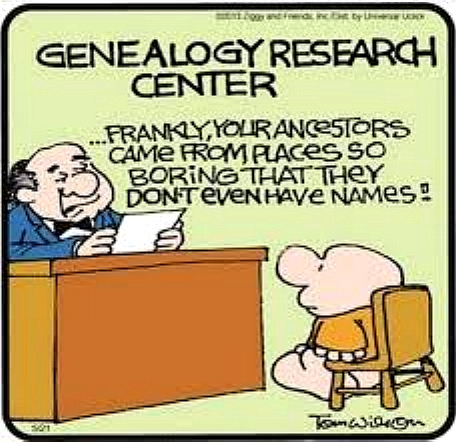 |
|
2) FINDING OUR BUGNITZ BURGENLAND FAMILY (by Eileen and Christine Bugnitz) Editorial note: Last month I reported that Werner Stubits, a board member for the researcher community ÖFR (Österreichische Gesellschaft für Familien- und regionalgeschichtliche Forschung = Austrian Society for Family and Regional Historical Research; website at www.OEFR.at), had arranged to have two articles included in the Society's recently-published yearbook. The first was about the Stubits reunion, republished in the BB newsletter last month. The second story is about re-establishing connections with the Bugnitz/Bugnits family of Harmisch, as told by Eileen Bugnitz. Her sister, Christine Bugnitz, is integral to that story and wrote a poem (also included here) about that experience. Werner's 4th great-grandfather is Eileen and Christine's 5th great-grandfather, and the Gerhard Bugnits in the story below is Werner's first cousin. Werner arranged permission for us to re-publish this material (and we thank him for that!). So below, please enjoy the words of Eileen and Christine... Finding Our Bugnitz Burgenland Family (by Eileen Claire Bugnitz) 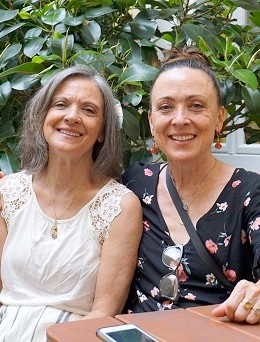 The
journey back to my family’s homeland begins with my sister, Christine, who, after some years of internet research, learned
an important piece of information that led my family to present-day Harmisch, a small village in the province of Burgenland,
Austria. The
journey back to my family’s homeland begins with my sister, Christine, who, after some years of internet research, learned
an important piece of information that led my family to present-day Harmisch, a small village in the province of Burgenland,
Austria. But first, a little background of what we knew about my father’s family prior to her research... We knew that my grandfather, Leopold Bugnits, was born in Austria. He was the first-born of his parents, Matthias and Anna. In 1904, Leopold emigrated to the United States with his father. Some time later, his mother, two sisters and his younger brother journeyed across the ocean, as well, to join them. The family settled in St. Louis, Missouri. In St. Louis, my grandfather met and married Julianna Taschler, a fellow Austrian. She had emigrated to St. Louis around the same time as Leopold. Their union produced eight children. My father, Julius, was one of them. And that’s essentially all of what we knew. There are a few reasons for our lack of knowledge about our heritage. One is that my grandmother had died long before most of us kids were born, so she simply wasn’t around as a source of information. Another is that my grandfather was a quiet man with little to say, who spoke with a fairly heavy accent so his few words were difficult to understand. We never once heard him speak of his life before arriving in the States and had absolutely no idea from what part of Austria he came. We never learned the names of the villages in which he and my grandmother were born, and I don’t believe my father did either. Additionally, I think many immigrants didn’t often speak of their “former” life. In an attempt to be considered as American as possible, as soon as possible, they spoke little of their homeland. As a result, my family knew next to nothing about my grandparents’ origins. From where, exactly, had they emigrated? What was life like in their homeland? Did they still have family there? Why did they leave? As it turns out, there was one person who had answers to a few of these questions. My father had a sister, Lillian, who seemed to be the one child of Leopold and Julianna who was most interested in their Austrian heritage. As adults, and long after my grandfather and father had died, we discovered that my Aunt Lillian had learned a bit of information about her parents’ homeland through questions that she had asked them when she was growing up. She knew that her mother was born in Deutsch Schützen and that her father came to the States from Pernau (but did not know that he wasn’t actually born there). She knew that her father spoke of swimming in a river called the Pinka but did not know where it was. And that was about the extent of her knowledge of her parents’ origins. Cut to 1997 when my sister’s curiosity started her on an internet journey to find out more about our roots. Through intermittent internet research over the following five years, she made some discoveries, including exactly where these Burgenland villages are located on a map. Further sleuthing connected her with someone through this online group, the Burgenland Bunch. This person, John Lavendoski, generously and skillfully assisted Christine with her research, and it was he who discovered the exact birthplace of our grandfather: house #1 in Harmisch. Armed with this information, a sleepless night led her back to the internet in search of the current resident of that very house. With no expectation that the current resident would have our last name, she accessed an Austrian telephone directory and made a thrilling discovery: the current resident was one Gerhard Bugnits. He MUST be related, she thought. She wasted no time in writing him a letter and, some weeks later, he happily replied that he was, in fact, related to us. He stated that we shared a great-great-grandfather. His great-grandfather and our great-grandfather were brothers. After almost 100 years, contact was re-established with our “motherland,” and it was a joyous occurrence for my entire family, particularly my Aunt Lillian. Though no plans were made for an in-person meeting, we were all quite happy to now know exactly where we came from on our father’s side, and that was pretty much the end of it. Until… In late January of 2007, I was about to embark on my first journey overseas—a three-week road trip through central and eastern Europe. The night before I left, my sister, Christine, called me and suggested that, if I would be in the area of Burgenland, maybe I could try to find Harmisch and check out the house where Leopold was born. Though she hadn’t been in contact with Gerhard since they exchanged letters in 2002, I excitedly agreed that I would do that. I arrived in Harmisch in the late afternoon of Sunday, February 4—I specifically remember that it was Superbowl 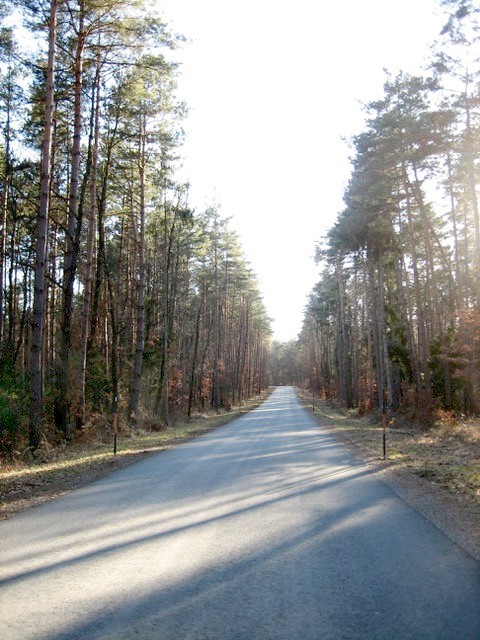 Sunday
in the States. As I approached the village of Harmisch I became overwhelmed with emotion, as I was the first family member
to return to Burgenland since my grandfather left in 1905. I pulled the car over to collect myself before I entered the
village. Sunday
in the States. As I approached the village of Harmisch I became overwhelmed with emotion, as I was the first family member
to return to Burgenland since my grandfather left in 1905. I pulled the car over to collect myself before I entered the
village.I took a short walk in the forest on this beautiful winter day and thought about my dad, who had passed away many years earlier, never realizing his dream of traveling to Europe himself. I thought that he would be happy and proud that I was there. I thought of my grandfather and what it must have been like to leave a small, beautiful village like this and travel thousands of kilometers to a world unknown, with no guarantee of what might happen when he arrived. Was he sad to leave? Was he scared? I thought of the enormous amount of courage that it took to do what he did. I gazed to the ground and saw several tiny pinecones laying on the forest floor. I collected eight of them—one souvenir for me and each of my siblings back home. 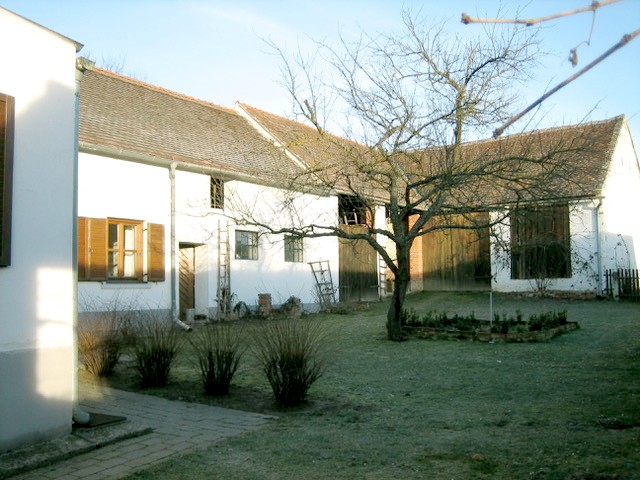 I
got back in the car and proceeded into the village, finding house #1 on the opposite end. I wanted to approach the house and
knock on the door, but I was scared, as whomever was there had no idea that I was coming. I didn’t know how they would
receive me. Would they welcome me? Would they turn me away? Would they greet me at the door with a shotgun? I almost
drove away without even trying... but then decided that I had to knock on the door because I had come such a long way
and may never get this chance again. I
got back in the car and proceeded into the village, finding house #1 on the opposite end. I wanted to approach the house and
knock on the door, but I was scared, as whomever was there had no idea that I was coming. I didn’t know how they would
receive me. Would they welcome me? Would they turn me away? Would they greet me at the door with a shotgun? I almost
drove away without even trying... but then decided that I had to knock on the door because I had come such a long way
and may never get this chance again.So, I knocked on the door and was greeted by two beautiful women—one older and one younger—and a little black dog. I nervously started speaking to them in English, trying to explain who I was. The look of confusion on their faces indicated that they understood little of what I was saying. Ultimately, I took out my passport, opened it to the page with my name, and held it up in front of them. When they read the name their faces lit up, and they excitedly invited me in. 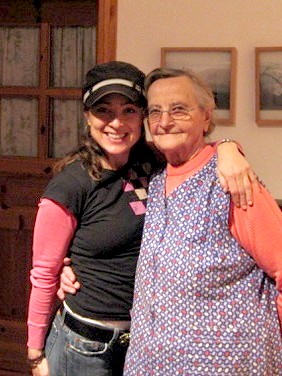 They
sat me down in the kitchen while one of them went to another part of the house to get Gerhard. (As it turned out, the older
woman was Gerhard’s mother, Anna, and the younger woman was his niece, Nicole.) Though there was definitely a language
barrier, Nicole spoke a decent bit of English so, through that and a lot of picture-drawing with pen and paper, it became
clear to them exactly who I was and how we were related. It was such an exciting, emotionally overwhelming experience
that we all had to part ways for a bit and collect ourselves and our thoughts about what had just happened. Before I drove
away, we made a plan to meet back up at the house in a few hours for dinner. They
sat me down in the kitchen while one of them went to another part of the house to get Gerhard. (As it turned out, the older
woman was Gerhard’s mother, Anna, and the younger woman was his niece, Nicole.) Though there was definitely a language
barrier, Nicole spoke a decent bit of English so, through that and a lot of picture-drawing with pen and paper, it became
clear to them exactly who I was and how we were related. It was such an exciting, emotionally overwhelming experience
that we all had to part ways for a bit and collect ourselves and our thoughts about what had just happened. Before I drove
away, we made a plan to meet back up at the house in a few hours for dinner.I was in a daze as I drove away from the house and had no idea where I was going for the next few hours but ultimately ended up in the town of Kohfidisch. I decided that I had to call my Aunt Lillian and tell her what had just happened, so I pulled the car over and did just that. We both cried tears of happiness when I gave her the news. Of Leopold and Julianna’s eight children, she was the only one still living and the one who was the most interested in their heritage, so it brought me great pleasure to be able to share this with her. 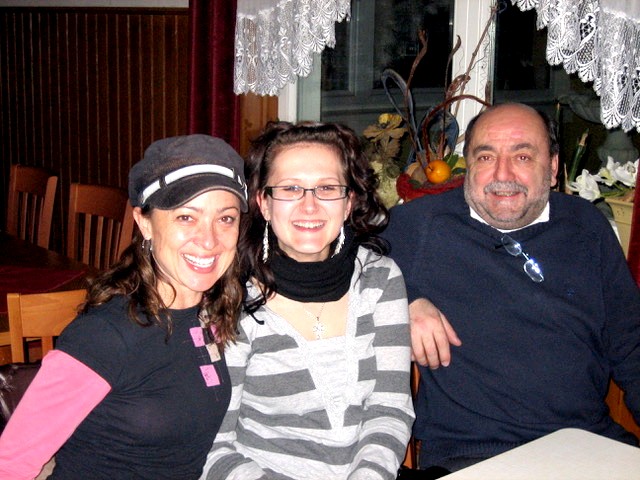 After
a few hours I returned to Harmisch. Gerhard and Nicole took me to a wonderful dinner in Csaterberg, after which they
insisted that I spend the night at the house. After
a few hours I returned to Harmisch. Gerhard and Nicole took me to a wonderful dinner in Csaterberg, after which they
insisted that I spend the night at the house.As I lay in bed that night, my head was absolutely swirling with countless thoughts of all of my ancestors who came before me. I couldn’t believe that I would actually be sleeping in the house where my grandfather was born and all of my great-grandfathers before him. I couldn’t believe how kind and generous and welcoming Gerhard and Anna and Nicole were, especially given the fact that I had just “dropped in” on them from another country. From the moment they met me, they treated me as family. I thought of my dad and wished he would have been the first one to go back—that honor should have been his. But I was also happy to be the one to do it in his absence, and I felt so very grateful that I could. I had no idea of what would transpire when I went there, but I can tell you the entire experience turned out to be far more profound than I ever expected. It was pure magic. I left the next morning with a full belly, a full heart and the promise of a return visit. I’ve kept that promise and, prior to the pandemic, returned every year, sometimes twice a year, to nurture and strengthen the bond with my new-found family members, meeting new ones along the way. Four of my seven siblings have also made the pilgrimage more than once, and I hope the other three will be able to, as well. It has been an incredibly fulfilling, meaningful experience for us to not only get to know our family, but also get to know Burgenland—its beauty, its customs, its traditions and, most importantly, its wonderfully warm people. As a result, we all feel very much comfortable and at home there. It feels peaceful to us, like everything has come full circle and is complete—like we’re back where we belong. We realize that most people in life don’t get the opportunity to visit the country or the village or the actual house from which their family came, and we all feel so much gratitude for being able to do that. My yearly visits have become an integral part of my life’s happiness. I absolutely love my Austrian family and can’t wait to see them all again. Reconnecting with my roots has been one of my life’s most profound, meaningful experiences, and I will be forever thankful to my Burgenland family for making that possible. Eileen Claire Bugnitz is a native of St. Louis, Missouri, and is a descendant of Burgenländers from Harmisch and Deutsch Schützen. She became interested in genealogical research after her sister, Christine Bugnitz, initiated contact with relatives living in Harmisch almost 20 years ago. She currently resides in Los Angeles, California and works as a hairstylist in the film and TV industry. Prior to the pandemic, she visited her Austrian relatives every year, starting in 2007, and hopes to resume those visits in 2022.
|
|
4) HISTORICAL BB NEWSLETTER ARTICLES Editor: This is part of our series designed to recycle interesting articles from the BB Newsletters of past years. The entry below, from 10 year ago, describes a Vienna orphan who was fostered in Burgenland. At the time this article was published, accessing records in Vienna was quite difficult... but that has changed. So below I give you the original article and then supplement it with a little 2022 research. THE BURGENLAND BUNCH NEWS No. 218 February, 2012 A VIENNA ORPHAN (by John Holler) In his last illness, my father called to me. He said that he dreamed of his mother and she was crying because she didn’t know whom she was or why she was given away. He wept for her remembered pain. So now, years later, I am searching for those answers. My grandmother was born Louise Khaupt on September 17, 1888 in Vienna, Austria. She was sent as a foster child to live with Peter and Erzebet Tamedle in Burgenland. Who were her birth parents? Why was she sent to grow up in Western Hungary? These were questions that haunted her all her life. Her daughter, Helen, told me she always hated filling out forms because she didn’t know what name to use. Who was Louise Khaupt? Peter and Erzebet Tamedle were a young Burgenland farm family with small children of their own to raise. They decided to foster Louise. Perhaps they needed the money the government offered for taking in these children. I do not know how old she was when she came to Burgenland. Louise had at least 5 foster siblings. She was cared for and loved by her brothers and sisters but never felt that she belonged in Burgenland. “A Vienna Bastard, that’s what I was called,” she said. The pain of those words was still with her half a century later. She grew up in a small community, Geresdorf, that valued strong family ties but she was forever an outsider with no family of her own. The Vienna foster children were supposed to be returned to Vienna after 6 to 10 years. If Louise was ever given that choice, it was never mentioned in our family. Louise wasn’t sent to school with her brothers and sisters but had to stay on the farm and help with the chores. Although school was mandatory at that time, there were fees involved. Perhaps the family or community had no money for her fees. Perhaps it was felt Vienna orphans weren’t worth the cost of educating. She knew that, without an education, her future was bleak. The stigma attached to being a Vienna orphan ruled out marriage. “Oh, no one would have married me, not if I stayed there,” she would whisper and shake her head. Louisa’s elder foster sister, Terez, immigrated to America and married a man named Beidl. After Terez was settled in Troy, New York, she sent money for her younger sister Maria to come to America. A whole new life opened for Louise because she was to accompany the 16-year-old Maria to America. They traveled to Antwerp and boarded the “Zeeland” bound for Ellis Island in the spring of 1909. In the fall of 1909, Frank Holler left Fürstenfeld, Austria, for Ellis Island. Eventually he made his way to Troy, NY, where he met and married Louise. They moved to New York City. Louise was pregnant with her first child, so Maria went to New York with Louise and Frank. One day Maria went to market and never returned. Though the family searched everywhere, no one ever heard from Maria again. A young girl lost to the streets of New York. 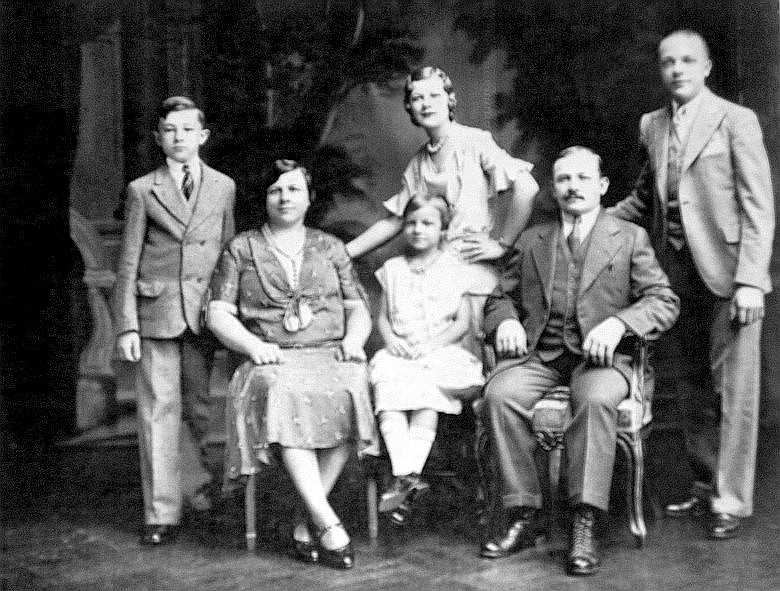 The Holler family c.1930; Frank and Louise Holler seated. Frank did not melt in the melting pot of New York. He was German. Only German was spoken in his house. He read German newspapers, listened to the German radio station and worked in a German brewery. When the children started school, they spoke only German. It was up to Louise to learn to speak, read and write English. She said that she had to teach herself these things because she needed to help her children with their schoolwork. English was spoken in the kitchen; elsewhere in the house, German was spoken. Ironically, as Louise reached a great age (she lived to be 94 years old), her mind traveled back to her days in Burgenland. She wanted to know why and how and would not accept pacifying clichés such as “your mother probably thought she was doing the right thing,” or “we’re all happy the way it turned out.” She wanted answers... but there were no answers for a Vienna orphan. Now, over a hundred years after Louise was born, I am searching for those answers... in her honor. 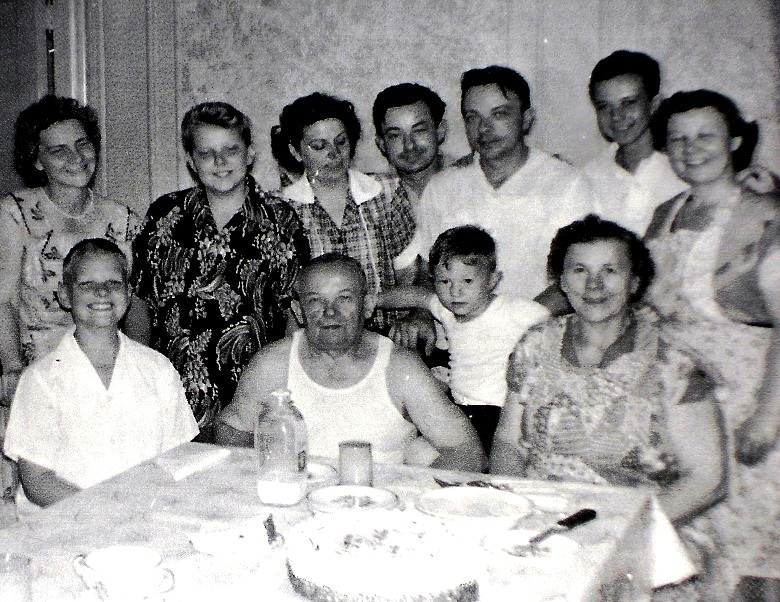 The Holler family 1954; I am the boy between my grandparents. So that is where things stood ten years ago... Although we provided information to the article's author, John Holler, about how to research further (it was hard then!),
he never told us about his results, if any. In the past year, however, I have written a number of times about how that
research process has become easier, what with GenTeam's databases and the Catholic church records for Vienna being
online, so I decided to see what I could learn now. |
|
5) ETHNIC EVENTS LEHIGH VALLEY, PA Sunday, March 6: The Jolly Bavarians at the Coplay Sängerbund. Info: www.coplaysaengerbund.com Friday, March 11: Kermit Ohlinger at the Reading Liederkranz. Info: www.readingliederkranz.com Saturday, March 12: Bockbier Fest at the Lancaster Liederkranz. Music by Heidi & Heimatecho. Info: www.lancasterliederkranz.com Sunday, March 13: St. Patrick’s Dance at the Coplay Sängerbund. Entertainment by Maria & John and the O’Grady-Quinlan Irish Dancers. Info: www.coplaysaengerbund.com Sunday, March 20: Cabbage Hill Day at the Lancaster Liederkranz. Entertainment by the Emil Schanta Band and club folk dancers and singers. Info: www.lancasterliederkranz.com Sunday, March 20: Josef Kroboth Orchestra at the Coplay Sängerbund. Info: www.coplaysaengerbund.com Friday, March 25: Kermit Ohlinger at the Reading Liederkranz. Info: www.readingliederkranz.com Sunday, March 27: Emil Schanta Band at the Coplay Sängerbund. Info: www.coplaysaengerbund.com NEW BRITAIN, CT Friday-Sunday, 1-8 pm: Biergarten is open. Austrian Donau Club, 545 Arch Street. ST. LOUIS, MO (none) UPPER MIDWEST (none) |
|
6) BURGENLAND EMIGRANT OBITUARIES Albert Muller  Albert F. Muller, 89, of Plainville,
Connecticut, passed away on Wednesday, Jan. 26, 2022, at the Hospital of Central CT in New Britain. Albert F. Muller, 89, of Plainville,
Connecticut, passed away on Wednesday, Jan. 26, 2022, at the Hospital of Central CT in New Britain.Born in Minihof-Liebau, Austria, he was the son of the late Frank and Rose (Holzmann) Muller. Albert was a U.S. Navy Veteran. He was formerly employed at the State of CT Department of Transportation before retiring. Albert was a member of the Plainville Congregational Church and the Plainville Senior Center. He was a talented artist and also enjoyed bicycling, and swimming. Surviving are his brother, Ernest Muller; his cat Missy; a close friend and caregiver, Tracy LaVallee and her mother, Anna LaVallee; his cousin, Alan Miller; and many friends including Tina, Roddy, Jill, and Mark. Funeral services will be held on Friday, Feb. 4 at 12 p.m. at Erickson-Hansen Funeral Home, 411 South Main St., New Britain. Burial, with military honors, will be in Fairview Cemetery. A calling hour will be held from 11 a.m. until the time of the service. www.ericksonhansen.com Published by The New Britain Herald from Feb. 2 to Feb. 9, 2022 |
|
| END OF NEWSLETTER (Even good things must end!) |
|
|
Burgenland Bunch Newsletter, copyright © 2022 by The Burgenland Bunch |
 News
News